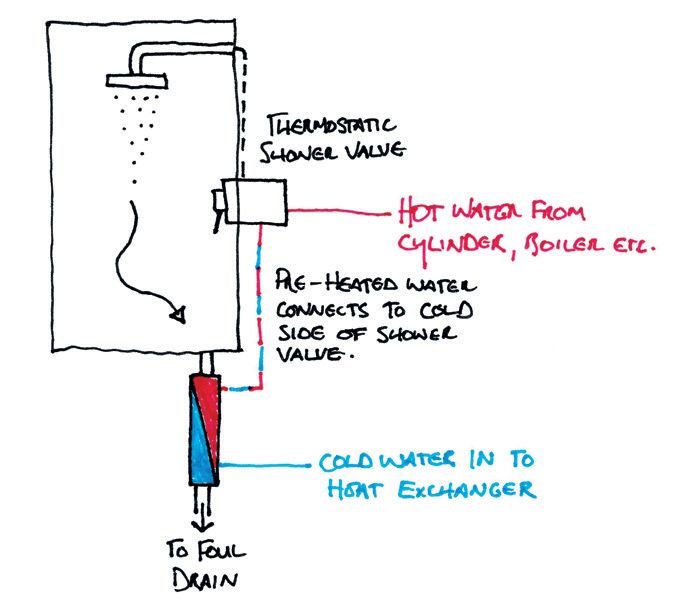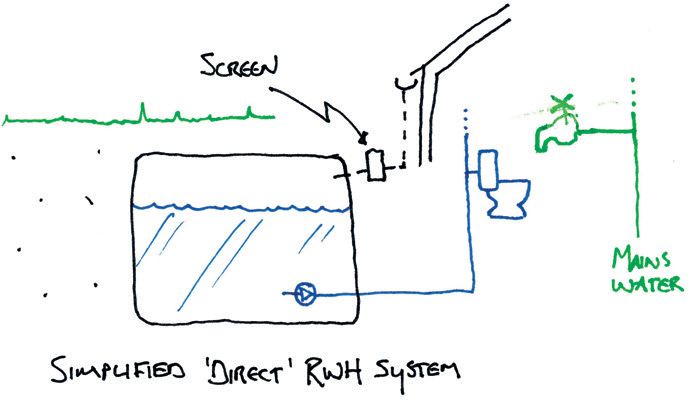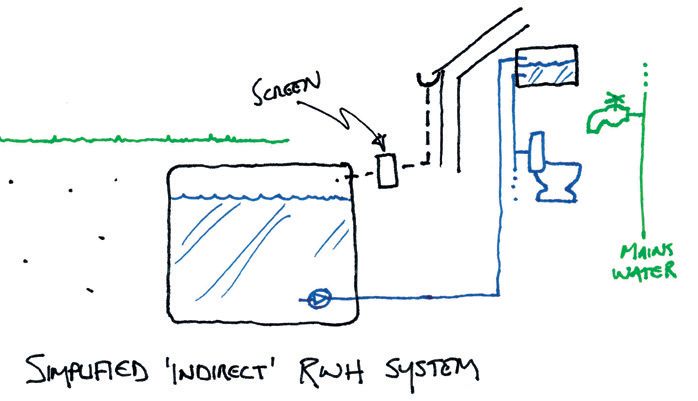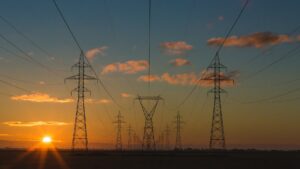Traditionally constructed buildings are difficult to insulate to the levels expected of modern houses without damaging them. On the one hand there is a risk of interstitial condensation saturating the fabric, causing mould growth and even greater heat loss. On the other there is the impact that changes to the fabric can have on character and significance, particularly where the building is listed. So we tend to look for other methods of increasing their efficiency. Waste water is one of these. Whenever we pull the plug from the bath, empty the washing up bowl or take a shower, we literally pour valuable resources down the drain. As well as the water itself, significant amounts of heat energy in warm water is lost. This raises the question: what can be done to reduce, re-use and recycle these resources?

Meeting climate-change targets requires retrofitting measures for existing and historic buildings, but some measures can be counter-productive
Grey Water and Rainwater Recycling
The Environment Agency (EA) regularly publishes a map that indicates the UK’s level of water stress, which compares the inputs from rain with the outputs from abstraction in each body of water. Much of the UK is classified as low stress, thanks at least in part to its infrastructure which transports water from reservoirs to the cities; however, it still has significant areas of moderate and high water stress that may increase with the growing population. Additionally, the uncertainties around the effects of climate change are likely to lead to more extreme weather, possibly making it harder to capture and store water.
Water companies are constantly encouraging us to reduce our consumption, many of them giving away useful items such as shower flow regulators, and Part G of the building regulations places stringent design limits on water-use in new build homes. With all this in mind, it might seem sensible to re-use waste water from wash-hand basins, baths and showers, known as grey water, and to collect and utilise rainwater.
Shades of grey
Grey water is the effluent from handbasins, baths and showers which is not fit for drinking but is fine for flushing the toilet. Rainwater is similar, but is also used for laundry, watering the garden and washing the car. Black water is a polite term for the effluent discharged from WCs, and it usually includes water from kitchen sinks and dishwashers, which contain grease and food particles that make it difficult to re-use. Water straight from the mains, or that has been processed to specific legal standards, is called potable.
In principle recycling water is simple: store rain or grey water in a tank and feed the toilets and other facilities as and when. However, as with many topics in building, the devil is in the detail.
Rainwater systems
All systems need some sort of treatment: for most rainwater systems this can be as simple as a filter to separate out leaves and other debris. Rainwater tanks are sized to last through dry spells, but the length of the dry spell to design for is debateable. 3,000L for a single three-bedroom house is typical, or a 1,800mm by 1,700mm cylindrical vessel. After the bulk storage tank, there are two distribution options often referred to as direct and indirect. Direct is the most common option for domestic properties and involves pumping the water out of the bulk storage tank and, excepting a few valves and accessories, straight into the pipework that feeds the WCs and other appliances. Indirect systems pump water up to a smaller header tank which feeds the appliances by gravity. In both cases, an electric pump is essential, as is the additional pipework to carry the non-potable water this means the amount of cold water pipe work can nearly double. Occasionally a site will lend itself to a gravity only system, but this depends on all the draw-off points being lower than the bulk storage, which itself must be lower than the roof or collection area.
Grey water systems
Grey water must often be treated more thoroughly than rainwater because the presence of dirt, soaps and other substances can support biological growth leading to odour, discolouration and pathogens. Immediate direct re-use, for example watering the garden with used bath water, requires no special equipment or installations but is inconvenient. Some systems minimise the necessary treatment by storing grey water for only a short period. This can involve dedicated control systems that purge the storage if for example a family goes on holiday. The other option is to treat water more thoroughly by biological, mechanical or chemical means so that it can be safely stored before re-use, but this is unusual. The storage tanks can be smaller because they are not vulnerable to dry spells of weather, and supply will track demand fairly closely. A day’s supply might be sufficient storage in a grey system, whereas a rainwater system might need a few weeks’ worth or water in reserve. However, these treatment systems can be quite extensive, and it usually still has to be pumped back to the point of use.
A key consideration for both types of system is that it is often necessary to almost double the extent of the cold water pipework, because many areas need both potable and rain or grey water supplies. If an existing building is being converted or thoroughly re-plumbed then it might make sense to fit the extra pipework, but generally it is not feasible to open up an old building just to install such systems.
All this assumes the water is not to be rendered potable, which is significantly more demanding in terms of treatment; the necessary filtration and sterilisation is possible, but relatively complicated, involving finer filtration and possibly the addition of chemicals and UV lamps.
The gravity of the situation
A 2010 report from the Environment Agency found that although there is scope to reduce the carbon footprint of grey and rainwater harvesting systems, ‘buildings using harvested rainwater or treated grey water typically increase greenhouse gas emissions compared to using mains water,’ when lifecycle impacts are accounted for. The operation of the electric pump is always one of the biggest, contributors to the lifetime footprint. A highly efficient circulation pump might achieve over 40 per cent efficiency, but the small submersible pumps used in recycling systems might be as low as 15 per cent. In many cases, below ground storage vessels must be encased in concrete to avoid buoyancy, in ground water. This greatly increases embodied energy and carbon.
For larger, non-domestic buildings, systems can be more efficient, so there can be some energy and carbon benefits, but there are likely to be more cost-effective ways of reducing the building’s environmental impacts.
Maintenance
Most water recycling systems require some level of maintenance. The British Code of Practice for Rainwater Harvesting systems, BS 8515, provides guidance on this, but the key points are to check for blockages, correct operation of mechanical and electrical parts, leaks, and the condition of filters. Given the parts lists of even a modest water recycling system, there are lots of opportunities for failure. Many systems incorporate some sort of mainsfed backup, and the Environment Agency’s report shows that it is not uncommon for failures to remain undetected, reverting the building to 100 per cent mains water.
The reality is that for most ‘normal’ buildings, it’s simply more environmentally friendly and economical to flush away mains drinking water than to capture, treat, store and pump rain or grey water.

A detail of a typical map issued by the Environment Agency showing water body stress levels in the South East.
Conservation: Sip, don’t gulp
Before splashing out on a rain or grey water recycling system, it is worth considering what can be done to reduce consumption. This can be often be done more cost-effectively through simple retrofits, upgrades or design changes, or at almost zero cost, by the occupants implementing behaviour changing measures like taking shorter showers.
Selecting smaller baths, dual flush WCs, flow-regulators and aerating taps and shower heads also form a key part of this approach, but ideally this should be coupled with careful system design to avoid unnecessary dead-leg volume and minimise the wait for hot water to arrive. Happily, consumer demand, Enhanced Capital Allowances and the application of Part G and the Code for sustainable Homes has driven development of useful water saving technologies in the last 10 to 20 years, and there is now a good selection of water saving equipment for both new build and retrofit applications.
Dual-flush WCs are all but standard today, and often cisterns can be retrofitted with a dual-flush. Many of these ideas can be incorporated into an existing building easily and inexpensively. A wholesale re-plumb will always present more opportunities to improve water and energy efficiency, but there is a great deal of low-hanging fruit not requiring such dramatic interventions.
Part G of the building regulations provide a legal minimum performance standard, but some would argue the water consumption calculation is somewhat arbitrary and open to abuse. The Association for Environment Conscious Building (AECB) Water Standards is an excellent reference point to use, with plenty of technical background. It promotes the control of flow rates at each outlet, which is simple and inexpensive to achieve via either flow-regulating tap aerators, or regulating valves provided to each outlet.
Reducing the water consumption of a building through good design and specification, as well as behaviour change, has multiple benefits. As well as reducing water stress and greenhouse gas emissions associated with the water, it reduces the energy required to heat water, and if a recycling system must be used, it can be reduced in size and cost.

A simple waste water heat recovery system for a shower
Heat Recovery
The heat demand of hot water systems can be considered in three main areas: usage (the energy in the water from the tap), storage losses (energy losses from cylinders and while boilers are on stand-by) and distribution (from pipe work, generally considered for these purposes in terms of primary and secondary circulation loops and dead-legs). In many systems, the storage and distribution losses far outweigh the useful heat demand, meaning that significant amounts of energy is wasted. This is mainly a summer time problem, when the waste heat doesn’t offset space heating and can be a major contributor to the risk of overheating.
The AECB also promote energy efficient design of hot water systems. Various design strategies can have a big impact, such as minimising primary and secondary circuits and insulating them properly, use of radial pipework and careful selection and location of the primary plant. Sometimes such strategies can conflict with regulations and strategies for mitigating legionella risk, which naturally takes precedence. However, in most cases, the conflict arises from other constraints such as the long distances from storage to point of use. In new build, there is no excuse for such design errors, but when retrofitting, particularly in the constraints of heritage buildings, it can be more challenging to design out such issues.
Often, the best strategy is to simplify systems to the greatest extent possible. This sometimes means challenging beliefs around what is considered good practise. For example, a gas-fired system with poor efficiency might lose two-thirds of the input heat through storage and distribution, making it no less carbon and intensive or costly to run than a direct-electrical system. In such cases, it might be more sustainable, and less invasive and expensive to fit point of use heaters. However, every building should be considered on its merits which means a proper set of calculations to quantify the implications of different strategies.
Radial pipework is one strategy to address losses from circulation loops, and can be particularly interesting to those involved with heritage buildings because the pipe is typically narrower with flexible plastic, so installing it can be less disruptive than a conventional system. However, the layout of the building sometimes precludes this strategy because the length of each pipe is limited to between 12m and 15m.
WWHR: Making a full recovery
Another water technology that has gradually risen to prominence over the last 10 years or so is Waste Water Heat Recovery (WWHR). The water leaving our showers and baths is quite warm and has a useful amount of energy, which can be used to heat incoming water from the mains.
It is feasible to recover some of this heat, and there are various products commercially available to achieve this. However, the simplest possible way to harness the heat from your used bath water is simply to wait until it is cool before you pull the plug. As it cools down, its heat is transferred to the air in the building. If using technology to make life easier, showers are the best candidate because typical heat exchangers depend on transferring energy from one stream to another in real time. The delay between running and draining a bath means simple heat exchangers won’t really work. WWHR devices usually either replace a section of waste pipe or SVP, or are built into a special shower tray. The in-line types consist of a section of waste pipe with a coil or jacket around it which carries the cold fresh water on its way to the shower mixer or DHW cylinder. They are often copper, a very good conductor, to maximise heat transfer. They must be mounted vertically to allow the warm waste water to spread around and maximise contact area inside the pipe. This can make finding a suitable location tricky, in which case the in-tray devices may be more appropriate, although they tend to be less efficient.
Typical heat recovery efficiencies range quite widely from 40 per cent to 70 per cent depending on the device, flow rate and the way it is plumbed in. For many modern households, showers are the main use of hot water, so a significant proportion of hot water energy can be offset. The technology is free of moving parts, and is at no more risk of blocking than a normal drain, so is as close to maintenance free as is possible. Like the water efficiency strategies, reducing the hot water energy demand has several benefits – reducing carbon and operational costs, but also potentially reducing the size and cost of the primary plant. In some cases, the cost of the WWHR system can be wholly offset by the savings on the primary plant.
To conclude, in some cases it may be appropriate to install rain or grey water recycling systems in heritage buildings, however as in new build the environmental benefits can easily be outweighed by the costs. A careful assessment might show that a well-designed, installed and maintained system does yield ecological and economic benefits, but current evidence suggest that such cases are the exception and not the rule. Water conservation is much more likely to yield net benefits to energy, carbon and cost, because it can be implemented inexpensively, even in the case of a light-touch refurbishment. Waste Water Heat Recovery is increasingly considered in new build and refurbishments alike; although the best systems require some careful integration at both design and installation stages. As with the water recycling systems, the benefits can sometimes be negated in sub-optimal examples, so a proper analysis is essential.
References
The Consumer Council for Water, Water, water everywhere: delivering a resilient water system (2016/17), December 2017, http://bc-url.com/water-water-everywhere
Environment Agency, Water stressed areas – the final classification, July 2013, http://bc-url.com/water-stressed-areas
Environment Agency, Energy and carbon implications of rainwater harvesting and greywater recycling, 2010, http://bc-url.com/rainwater-and-grey-water-recycling
The Association for Environment Conscious Building, AECB Water Standards, 2009, http://bc-url.com/water-standards
First published in the Building Conservation Directory 2020






